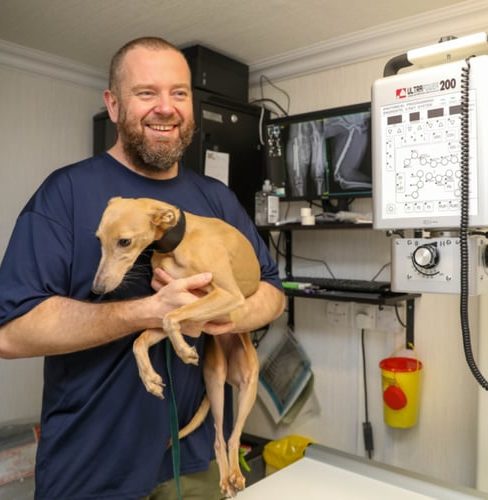Orthopaedics
From limping pets to complex fractures, we’re here to help get your animal back on their feet. With advanced training in orthopaedic surgery, our vet Łukasz leads this area of our practice, offering a wide range of surgical solutions right here on the Isle of Man — so there’s no need for off-island referrals in most cases.
Whether it’s a torn ligament, a dislocated kneecap, or a broken bone, we tailor each surgical plan to your pet’s individual needs, using the most appropriate technique to ensure the best possible recovery.
Our practice is fully equipped with digital x-ray imaging, allowing us to make accurate orthopaedic diagnoses quickly and confidently. We can also perform follow-up imaging as needed to monitor healing.

What We Offer
Cruciate Ligament Repair (TPLO, TTA, CCWO)
When a dog ruptures a cranial cruciate ligament — similar to an ACL injury in humans — it causes pain and lameness. We offer several surgical options depending on the patient’s age, size, and activity level:
- CCWO (Cranial Closing Wedge Osteotomy)/TPLO (Tibial Plateau Levelling Osteotomy) adjusts the angle of the knee to stabilise the joint.
TTA (Tibial Tuberosity Advancement) changes the direction of forces in the knee to restore stability.
Extracapsular Lateral Suture Stabilisation (ELSS): A strong suture is placed outside the knee joint to mimic the function of the damaged CCL, stabilising the joint.
- Ligament Replacement Techniques: Involves using synthetic implants, such as the NOVALIG® Synthetic Ligament, to replace the damaged CCL, restoring knee function.
Patella Luxation Surgery (TTT, Trochleoplasty, Ridge Stop)
If your pet’s kneecap (patella) keeps slipping out of place, it can cause discomfort and long-term damage.
TTT (Tibial Tuberosity Transposition) repositions the attachment of the patellar tendon for better alignment.
Trochleoplasty deepens the groove where the kneecap sits.
- Lateral imbrication involves tightening the lax connective tissue on the outer aspect of the patella to prevent the kneecap from moving medially.
Ridge Stop Technique uses an implant to keep the kneecap in place.
Distal Femoral Osteotomy Surgery (DFO) involves changing the shape of the deformed thighbone by cutting it just above the knee and stabilising it in a new position with a bone plate and screws. This may be all that is needed to prevent the kneecap dislocating. However, additional procedures, such as a tibial tuberosity transposition, may also be required.
Achilles Tendon Repair
Injuries to the Achilles tendon can be tricky, but we use NOVALIG® Synthetic Ligament to rebuild and reinforce the tendon for a strong, lasting recovery.
Fracture Repair (IM Pins, Plates, External Fixators)
Broken bones happen — and we’re fully equipped to handle them using a variety of methods:
IM pins are placed inside the bone for stability.
Locking plates provide rigid support, especially useful in complex or weight-bearing fractures.
External fixators are frames used outside the body, often for open or unstable fractures.
Humeral Intracondylar Fissure (HIF) Repair
Humeral intracondylar fissures are painful stress fractures within the elbow joint, most commonly seen in Spaniel breeds. If left untreated, they can lead to complete fractures of the humeral condyle. We offer surgical intervention to stabilise the bone, relieve discomfort, and reduce the risk of a future fracture. Early diagnosis through imaging and timely treatment are key to a good outcome.
Humeral Condylar Fracture Repair (HIRS, LEAP)
These fractures occur in the lower part of the humerus (upper front leg bone), right where it forms the elbow joint. They’re especially common in young, active dogs and in breeds like Spaniels that may have underlying bone weaknesses, such as humeral intracondylar fissures (HIF). This type of fracture can cause sudden lameness, swelling, and significant pain.
- HIRS (Humeral Intracondylar Repair System) provides robust internal fixation. This technique is specifically designed to compress and stabilise the fracture line while preserving joint integrity. It’s a strong, reliable method for managing this challenging injury, especially in dogs with underlying fissures or poor bone quality.
- LEAP (Lateral Epicondylar Anatomic Plate) is an anatomically shaped locking plate which offers precise fit and strong fixation to support the healing of complex elbow fractures. It’s particularly useful in cases where fracture fragments are small or the joint requires additional support post-repair.
Joint Taps & Injections
For some joint issues, surgery isn’t the first step. Łukasz also performs joint taps — a procedure that allows us to collect and analyse joint fluid to diagnose inflammation, infection, or other joint diseases.
When needed, we can treat affected joints with targeted injections using anti-inflammatory medication, hyaluronic acid, or Arthramid — a long-acting treatment that helps improve joint comfort and mobility.
